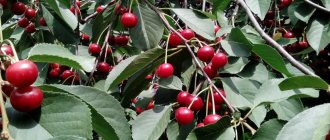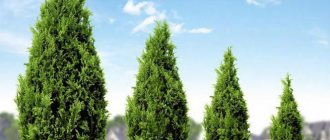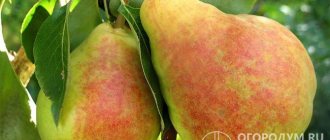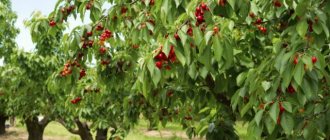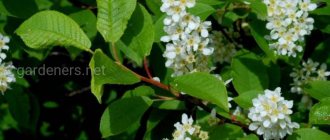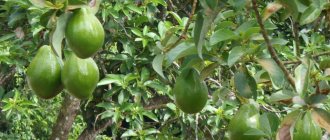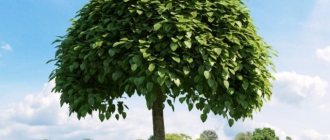The pear, along with the apple tree, is one of the most common cultivated plants among domestic gardeners.
This tree or shrub belongs to the Rose family (Rosaceae). The first mentions of pear fruits are found in ancient Greek sources. This plant includes both fruiting and ornamental varieties. There are several hundred fruit-bearing varieties, differing in taste, aroma and fruit size. The pear tree, under favorable conditions, can reach a height of 25 meters, and the crown size varies from 3 to 6 meters.
The pear is more prone to warm climates than the apple tree, however, some varieties are successfully cultivated in Western Siberia and the Far Eastern regions.
Planting a tree
Almost everyone knows when to plant a pear in the soil, but how to do it correctly remains a mystery to many.
Like all fruit shrubs, pear trees can be planted in early spring, before the buds swell, or in the fall; the choice of time of year for planting depends mainly on the region.
Winter varieties
These varieties are good because they have excellent winter hardiness and shelf-stable fruits.
Saratovka
The type is derived from German Bergamot and Winter Bere. The tree is cone-shaped, very tall.
- The fruits gain weight from 120 to 140 g, have an elongated shape, dull green color with a slight yellowness and a uniform surface.
- After ripening, the fruit turns bright yellow. The inside of the fruit is light, the flesh is saturated with moisture, sweet and sour.
- The fruits are not susceptible to various fungal diseases.
Kondratyevka
A very successful species was obtained as a result of breeding work at the Saratov State Agrarian University by G.V. Kondratyev.
- The tree grows up to five meters and begins to bear fruit in the 6th year.
- The fruits are moderate in size and filled with aromatic sweet moisture.
- The annual high yield of the variety is noted.
Pass-Krasan
The variety was bred in France in Rouen by A. T. Boisbunel in 1845. The tree is of small height with fruits weighing 180 g or more, with a creamy tint, the inside is very tasty, juicy and melting. Fruiting occurs in 6-7 years. It is recommended to harvest the crop from the tree as late as possible for better storage.
Gardeners have noted the following varieties:
- Pervomayskaya, reminiscent of peach or pineapple in taste;
- Winter cube-shaped, the variety is aromatic and juicy, resistant to diseases;
- Hera, with high fruiting and disease resistance;
- Nika, has a red color and is not susceptible to disease;
- Extravaganza, a very large green fruit with a red side.
Spring
Benefits of spring planting:
- In the middle zone and in the northern regions, summer is short, autumn is cool and winter is harsh and comes early; if a pear is planted in the fall, it simply does not have time to take root.
- In spring, the soil contains a large amount of moisture from melted snow, which helps the seedling to adapt.
- The hole dug in the fall will stand and be ready for planting by spring.
- A pear tree will have an average of about 5 months to grow.
- For several months, throughout the warm season, the young tree will be under the control and supervision of the gardener, who will be able to help him if necessary.
Caring for fruits
Pears are very delicate fruits. Therefore, remove them from the tree carefully so as not to damage them. The bruised fruit begins to rot very quickly. The same thing happens when his skin is accidentally damaged.
- To keep fruits longer, they are placed in wooden boxes lined with a layer of paper.
- The boxes are closed and stored in a cool and humid place.
- An ideal place for this is, for example, a basement.
- All damaged fruits are removed in advance.
- It's best to eat them right away or use them for twists.
Autumn
The autumn period is chosen by gardeners in the southern regions. A long, warm autumn and relatively mild winter allow the pear to adapt well and take root well.
The optimal time is the end of September, the first ten days of October. The choice of autumn for planting is determined by the hot, dry summer, when there is a possibility of the young seedling burning out.
Beauty Chernenko
This early-ripening autumn pear was obtained by crossing the Bere Ardanpon and Daughter Blankova varieties. Recommended growing region: Central. The harvest is stored for up to 2 months.
The beauty pear variety is a tall species with a rare crown shape - narrow pyramidal. The bark is smooth, brown in color. The branches grow vertically upward. The leaves are large, elongated, serrated, dark green.
The fruits are heavy, weighing 165-180 g, green-yellow in color with a brownish blush. The skin is of moderate density, with a slight coating of wax. The pulp is snow-white in color, moderately juicy, with a sweet and sour taste.
Start
Planting a pear and caring for it begins with choosing a suitable location.
It is worth remembering the following points:
- The pear has a highly developed root system that goes deep into the ground, so when planting, choose elevated places with a groundwater depth of less than 2 meters.
- The plant has a spreading crown, so each tree is given a 3x3 meter square for planting.
- The landing site should be protected from the wind, but not shaded.
Characteristic
The pear tree is a long-lived tree, as the normal life expectancy ranges from 100 to 200 years, and some specimens live up to 350 years. Pear is a deciduous tree. The crown can have a pyramidal or round shape. The fruits are elongated, cone-shaped, thickened towards the bottom, but some varieties may have spherical fruits.
Where does it grow
The habitat of this fruit tree is quite wide. It is common in all European countries, including Ukraine, Belarus and the lowland territories of the Caucasus republics. In mountainous areas, a wild variety of pear is common, producing small, sour and inedible fruits.
Pear is also successfully cultivated in some Asian countries.
The pear tree is especially popular in China and Japan. This plant requires neutral or slightly acidic soil. The best option for a pear tree is fertile and loose soil with low acidity and low moisture content.
It is not recommended to plant a pear tree on poor and low-lying soils, as it will be weak and painful. The tree also needs fresh wind, but not a draft.
Root system
The pear tree has a taproot system. In this case, the main roots practically do not branch and develop mainly in the vertical direction, reaching a depth of 6-8 meters. Large roots do not have noticeable horizontal branching, but thin roots (lobes) can extend 1.5-2 meters from the root system. They are usually located at a depth of 15-20 cm from the soil surface. The thin hairs located on the roots, which supply the tree with moisture and nutrients, are less developed than those of the apple tree. The vertical root system of the pear provides the tree with moisture even during dry periods, and allows the plant to tolerate drought more easily than other trees.
Sheet Description
The leaves of the pear tree have an oblong oval shape with small teeth along the edges and a pointed end. The length of the leaf varies from 3 to 10 cm. The color of the leaf on the outside is dark green and shiny, and the underside is green with a blue tint. In autumn, the underside of the leaf may turn orange. If you notice that the leaves on the pear have begun to curl, this indicates a leaf roller infection, the methods of combating which are described in this material.
What are fruit buds and what do they look like?
Pear fruit formations are usually located on overgrowing branches, which are divided into three types:
- twig;
- spear;
- ringed
A twig is a thin annual growth with a length of 15 cm. The top of the twig can bend down under the influence of gravity. The spears are up to 15 cm long and extend from the branch almost at a right angle.
Fruit buds located on the spears have a highly elongated shape and can resemble pointed thorns. The ringlet is the shortest and thickest process. Over the course of a year, it grows by 2-3 mm with the formation of a ring-shaped scar, the number of which can be used to determine the age of the tree. Flower buds form on such branches, from which fruits subsequently grow and new shoots form. An inflorescence with 10-15 flowers is formed on each bud. In some varieties their number can reach 25. This number of flowers provides a reliable reserve for fruiting. Even if most of the inflorescences are destroyed by the pear flower beetle, the tree will still have a sufficient number of flowers to obtain a normal harvest. Why the pear does not bloom or bear fruit, and what to do about it, read here.
A valuable property of pear buds is the wide variation in blooming time, so spring frosts are not able to destroy all the ovaries. In any case, the pear tree will bear fruit and produce a harvest.
Pear wood and its properties
Pear wood has high hardness, density and viscosity, which makes it possible to use it for making furniture and, especially, for decorative items. The density of the wood makes it difficult to process, but during the drying process, the finished product does not crack or warp, which is why pear is often used for patterned carvings.
The treated surface has a very smooth, clean structure. Relief boards for the famous Tula and other gingerbread cookies are made only from pear wood. Printed boards are durable and do not deteriorate from contact with moisture and culinary ingredients.
Read about what to do if the bark of a pear tree is cracked.
A pattern of any complexity can be cut out on the surface of a pear wood product.
Finishing veneer, parquet boards and some drawing tools are made from pear wood. In addition, beautiful wood is used to decorate the interiors of exclusive cars. Pear wood has a pale lilac hue, which over time acquires a noble dark pink color, which is highly valued by manufacturers of luxury furniture.
The wood does not deform either when connected with screws or glue. Any varnishes and paints made from natural ingredients or based on polymer materials can be applied to the surface. Pear wood is used in the manufacture of musical instruments and as a substitute for expensive ebony.
The disadvantage of such wood is considered to be the presence of curls, curvature and cross-layers. Pear boards often contain large knots, which makes them difficult to use for the production of large products.
Bloom
Pear blossoms usually begin in May, and early spring contributes to the beginning of the process in early May. If spring is delayed, then the pear tree will bloom at the end of the month or even at the beginning of June.
Some late varieties also begin to bloom in the first ten days of June. The flowers of the pear tree are usually white or pale pink and have a diameter of approximately 3 cm. They are collected in umbellate inflorescences containing from 3 to 9 flowers.
Growing season
In the warm spring, the growing season begins for the pear. Its first manifestations are usually subtle. First, the buds swell slightly and the kidney scales begin to move apart. Then a green cone-shaped formation appears and flower buds appear.
For gardeners, the beginning of the growing season is considered to be a visually noticeable swelling of the buds and an increase in their size. A bud can be considered fully blossomed when the tips of leaves or flower buds appear at its tip. The end of the growing season is characterized by a complete cessation of growth of the vegetative parts, when the growth and flower buds are fully formed. Then flowers appear and the pollination process begins.
Description of the fruit
The pear fruit, in most varieties, has an elongated shape with a noticeable thickening at the bottom. Color varies from green and yellow to pink with a red blush. The pulp has a dense consistency and is very juicy when fully ripe. Unlike an apple, a pear has a fine-grained structure due to the presence of hard cellular formations called sclerids.
The pear fruit contains a large amount of vitamins and microelements.
Pears are especially rich in zinc and potassium, which restores disturbed electrolyte balance and helps remove excess fluid from the body.
Since the sugar in pears is represented not by sucrose and glucose, but by fructose, people with diabetes can safely consume it, since insulin is not needed to absorb fructose.
Process
Spring planting begins in the fall, and autumn planting begins a month before the planned action. The algorithm of actions is as follows:
Choosing a location. When choosing a location, you don’t have to take much into account the soil; the pear is not fussy, and if necessary, nature can be helped and the soil corrected.
Digging up the selected area, marking places for seedlings.
Digging holes, hole depth from 50 to 60 cm, diameter 0.8-1 m, walls - vertical with notches for root penetration.
The next stage begins immediately before planting the plant.
A small layer of drainage is poured onto the bottom of the pit, then humus, sand and mineral fertilizers.
Next, the seedling itself is placed in the hole, and all the roots are carefully straightened out, then they begin to sprinkle the hole with earth, periodically shaking the seedling, this is done to prevent the formation of air bags.
Along with the pear, a special peg is placed in the hole. The last point, the earth is compacted, special attention is paid here to the level of the root collar, it should be at a height of 3-4 cm from the ground. When shrinking, it should not go into the ground.
A young thin tree must be tied to a support.
Next comes abundant watering and mulching of the root surface of the soil.
What seedlings should you not buy?
Keep in mind that the seller may remain silent about some defects of his product. Therefore, you need to learn to recognize them yourself.
Tree root cancer
You should not buy seedlings from which:
- There are “bumps” on the roots - maybe this is root cancer
- Less than three thick main roots
- Peeling bark on the roots is evidence of freezing of the tree
- Wrinkled bark on the trunk and branches is a sign of insufficient watering
- The root on a fresh cut is dark
- Soft grassy shoot tips (autumn seedlings) are a sign of insufficient lignification
- Blooming leaves (spring seedlings) – they may wilt during transportation
Suppliers who value their reputation usually reject sick, damaged seedlings.
Care
Caring for a pear seedling is as follows:
- Proper planting;
- Timely watering, frequency and abundance depend on weather conditions;
- Weeding followed by careful loosening;
- Periodic feeding of fruit plants;
- Pest control and prevention are more beneficial;
- Crown formation, as well as sanitary and rejuvenating pruning;
- Preparing the plant for winter.
Division of varieties for fruiting time
Trees grown for fruiting are divided into summer, autumn and winter pear varieties. The taste characteristics of pears are very different.
There are varieties that need to ripen on the tree, others, ripening on the tree, lose their taste delights (a seemingly beautiful fruit turns out to be rotten inside), so they need to be picked unripe and left to settle for several days, then the sclereids soften and the pulp becomes soft, juicy and sweet.
Winter varieties are the lightest. They can ripen on the tree, but there is a risk that they will be caught by frost; ideally, they are picked unripe, taken to a cold place, and you can enjoy the aromatic fruit all winter.
The description of pears will present varieties of trees with different periods of fruit ripening, and also provide a photo for each variety of pear.
Feeding pears
If the tree is planted according to the rules, then it does not need to be fed during the first summer. Feeding the pear will begin from the second warm period. The whole process can be divided into several stages:
In early spring, almost as soon as the snow melts and the ground warms up, nitrogen-containing fertilizers are applied.
Then, after a few weeks, it will be the turn of organic fertilizer; it can be cow manure dissolved in water, bird droppings, or wood ash. This fertilizing can be carried out in several stages, and wood ash can be added last, just before the tree blooms.
After flowering, to improve fruit set, use a solution of nitroammophoska (it can also be simply mixed with soil and spread in the groove around the trunk).
The next stage is phosphorus and potassium, they will be needed during intensive fruit growth.
The last fertilizing with mineral fertilizers (except nitrogen) is carried out in late autumn, almost before the frosts, thereby preparing the pear for wintering.
Landing Features
There should be enough free space between trees
It is better to plant pears in the fall, at the end of September. Studies have shown that such seedlings take root better than those planted in the spring. Such trees become more resistant to weather changes, diseases and pests.
But autumn planting also has its drawbacks. A tree that is not yet strong can become food for rodents and receive significant damage. Also, the seedling can freeze very much in winter.
Moreover, if you plant a tree in the fall, then until spring it will not be known whether it has taken root and what happens to it. And if you carry out the procedure in the spring, then until frost you can control its growth and condition. If problems arise, there will be a chance to fix them.
If you plant a pear in the spring, this should be done as soon as the soil warms up. The main thing is to do it before the tree sap starts to move.
The pear needs space and air. Therefore, there should be 6-7 meters of free space between the trees. And between rows of plantings - up to 4 meters.
Planting in autumn
Soil mulching option
You can drive a support peg into the center of the planting hole, which will rise 0.5 m above the ground. A seedling is tied to a peg after planting.
A mound of soil mixture is poured near the support peg. A tree is placed on a mound and the roots are straightened. When covering the roots with soil, the trunk of the seedling must be shaken periodically to fill all the voids.
Having filled more than half of the hole, you can pour a bucket of water with the root there. Then continue pouring the soil mixture. When finishing planting, you need to check that the root collar of the seedling rises 3-5 cm above the ground.
At the very end, you need to carefully compact the earth around the tree trunk. Also form a circle with a diameter of 50 cm around the pear from an earthen bank approximately 5 cm in height. Pour a couple of buckets of water inside the circle (even if it was raining at the time of planting).
The final stage is mulching and fixing the trunk to the support (do not pinch!). The soil inside the earthen roller can be mulched with whatever is on hand.
It is important to leave 8-10 cm of unmulched soil around the central shoot. Otherwise, rotting of the part of the trunk where there is contact with the mulch may begin.
Planting in spring
Trees need to be pruned regularly
Planting in spring is practically no different from autumn. It is advisable to cut the roots to 10 cm. Additionally, you can dip the roots in a clay mash.
After planting, the leaves, if any, are carefully torn off. It is advisable to trim off the branches of 2-3 year old seedlings. All these procedures can be done during autumn planting.
Trimming
Do not confuse pear pruning with pinching; pruning is done in spring and autumn, pinching strictly in June.
Autumn pruning is recommended for sanitary reasons, when it is necessary to remove dried, injured branches, as well as those affected by various diseases. To decide how to prune a pear, you need to understand why it is being done, what the ultimate goal is.
The following types of pruning are distinguished:
- For crown formation, without tiered and whorled-tiered formation.
- Rejuvenating.
- Sanitary support.
Vitamins and nutritional properties
From a consumer perspective, the most important thing about pears is their taste and health benefits. First of all, soft and juicy pears with delicate sweet pulp and thin skin are valued.
These are dessert pears, harvested in late summer and fall. Winter varieties can be stored and used for canning.
- The more ripe the pear, the more sugar it contains. Firmer, slightly acidic pears also contain more fiber, pectin and tannins.
- In addition, pears are rich in carbohydrates and proteins. These fruits also contain a lot of vitamins - vitamin A, B vitamins (vitamins B1, B2, B3, B6 and B9), vitamins C, E and K, valuable fruit acids and mineral salts such as zinc, phosphorus, magnesium, potassium, sodium, calcium and iron.
- They are unique compared to other fruits because they contain small amounts of iodine, thereby supporting the functioning of the thyroid gland. Due to the significant amount of boron, pears are also believed to have a positive effect on brain function.
Eating pears, especially ripe ones, is good for digestion. It is recommended to eat them to speed up metabolism, as they stimulate the intestines. However, there is a risk of overdoing it on pears and causing diarrhea if you eat too many of them.
Pear infusion helps reduce fever and get rid of headaches. Pears also help with urinary tract inflammation and speed up the healing process of wounds.
Reproduction
Pear propagation occurs in the following ways:
- Seeds, used for breeding new varieties, not used by ordinary gardeners, unprofitable.
- Grafting is also a practically unused method.
- By layering, the preferred method, the young tree begins to bear fruit early and retains all its maternal characteristics.
- Cuttings, the most common method.
Decor
It is a summer variety. A distinctive feature is dwarfism. The crown is almost not formed. There are practically no side branches, but there are shortened shoots. The fruits are large in size, weighing up to 400 g. The color of the peel is greenish with a red tint. The pulp is granular, fleshy, sweetish. Fruit ripening occurs in August – September, starting from the age of three seedlings.
Winter hardiness is average. There is immunity to diseases of fungal and infectious etiology. However, there is a risk of aphid infestation. The crop is very demanding on soil quality, so it is important to apply mineral fertilizers on time.
Protection
Protecting pears from pests and diseases consists of the following measures:
- Timely and complete care (watering, fertilizing);
- Proper treatment of root soil: weeding, loosening, removal of fallen leaves, fruits, broken branches and debris, mulching;
- Correct and timely pruning, the type of pruning is selected for each tree individually;
- Treating the pear trunk with lime;
- Protection from cold weather;
- If pests are detected, it is necessary to use special chemicals as soon as possible to save the tree and crop.
Autumn varieties
Fruit during this period of time has a high shelf life compared to summer varieties.
Velesa (Daughter of the Excellent)
Obtained as a result of hybridization of Forest Beauty and Venus by breeders Yu. A. Petrov and N. V. Efimov.
- The fruits are medium and large in size with a green-yellow color and a delicate tan.
- The pulp is slightly creamy in color with a good sweet and sour taste.
- Stored in a cool place until the middle of the last month of autumn.
- After planting the seedling, fruiting begins in 5-7 years.
- Every year there is a high harvest and no signs of disease.
Bere Moskovskaya
The variety was obtained by several authors at the Moscow Agricultural Academy. K.A. Timiryazev as a result of pollination of the Olga variety with a mixture of pollen from several types of other pear varieties.
- The fruits reach 110 g, yellow in color with a red blush, which is distributed over the entire surface, and slight speckling.
- The pulp is slightly sour, light, very juicy, and has an oily feel.
- Harvest at the beginning of the first autumn month, stored until the end of the month.
- The variety is resistant to rot and other diseases.
Kieffer (Kieffer Seedling)
Bred in 1868 by P. Kieffer in the USA from Ussuri and sandy Chinese pears with random pollination from either Bere Anjou or Williams. The fruits are medium-sized, lumpy, cube- or barrel-shaped.
- They are picked green and when ripe they become a rich yellow color with rusty spots.
- The pulp is light yellow in color, very juicy, a little rough with a peculiar taste.
- The time for fruiting occurs after 5-6 years, the yield is plentiful every year.
- The fruits ripen at the end of September and are stored in a cool room until December.
Red-sided
The subspecies was obtained at the South Ural Research Institute as a result of crossing the varieties Nezhnost and Zheltoplodnaya by three authors: V. I. Putyatin, E. A. Falkenberg, M. A. Mazunin.
The tree is medium-sized, the fruits gain weight up to 130 g of a characteristic shape, have a very marketable appearance, are colored green at the time of harvesting, and when ripe a yellow tint with a red side appears. The pulp is juicy and tasty; the fruits are harvested before September 20 and stored for 1-3 months.
In memory of Yakovlev
This species was obtained by researchers from Michurin University in the process of hybridization of the Tema and Olivier de Serre varieties. A small tree produces small, heterogeneous fruits with a smooth, shiny surface.
They are removed when the color takes on a pale yellow color; during the ripening process, the fruit turns bright yellow with a pink tan.
You can also note good varieties:
- Moskvichka, the variety was bred specifically for the Moscow region;
- Marble, a variety cultivated from Forest Beauty and Winter Bere.
Photo of pear
Honey
Popular middle-aged. Used by designers to decorate the landscape. If acceptable conditions are created, one tree can produce up to 15 kg of fruit.
Fruiting occurs at the age of three. The fruits are slightly ribbed and unevenly convex on the sides. The weight of one fruit can fluctuate within 400 g. The color of the skin is yellow-green. The pulp is fleshy, with a strong aroma, sweet.
The trees tolerate winter well and are resistant to disease. Due to their unpretentiousness, they are recommended for beginning gardeners.
Among such a huge variety of varieties, even the most fastidious gardener will be able to choose the option that best suits its characteristics. Before going to the store, you just need to clarify the climatic conditions of your area and decide on the optimal fruiting period for you.
Methods of grafting pear trees
In addition to the pear itself, the rootstock can be apple, quince, or shadberry.
Gardeners vaccinate in different cases:
- if you wish, experiment, create a new variety;
- if the tree breaks, but the root system remains intact;
- lack of space on the site;
- when there is a shortage of planting material of a rare variety.
First of all, prepare the rootstock. A month before the procedure, it is hilled up; just before grafting, the seedling is watered and freed from growth.
Copulation
The easiest way, accessible even to novice gardeners. It consists of connecting oblique cuts of the rootstock and scion of the same diameter, fixing them with film or electrical tape. For better sealing, the grafting site is lubricated with varnish on top of the winding material. If the grafting is successful, then after 14 days the scion buds will begin to develop.
Into the cleft
This method is best for rejuvenating an old garden. The vaccination is done in early spring. The trunk and crown are cut down, leaving only a small stump. A split is made on it up to 5 cm deep. A cutting is inserted into it with an oblique cut, and the trunk is tied with binding material.
When docking, you need to make sure that the cambium layers match. The grafting site is lubricated with garden varnish. If the diameter of the trunk allows, you can plant two cuttings at the same distance from each other.
After successful grafting, the scion will sprout within three weeks. If the grafting is unsuccessful, the cutting will dry out.
Under the bark
The method is quite simple. The grafting is done in May, when the bark is easily separated from the cambium. The rootstock is shortened and the lower branches are removed. The bark is trimmed in the longitudinal direction by 4 cm. The scion is cut with an oblique cut. Opposite this cut on the reverse side there should be a kidney. When the scion is connected to the rootstock, this bud is located in the center of the graft, which is tied and lubricated with garden varnish.
Budding
Vaccination is carried out in August before the end of the growing season. The method is widely used due to its high survival rate. A bud with a layer of bark and wood is cut from an annual shoot. An incision is made in the bark of the rootstock into which the bud is inserted. The grafting site is fixed and covered with garden varnish. The bud and rootstock must be genetically compatible.
By the bridge
This type of grafting is used to save the garden when the bark is damaged by rodents, sunburn and frost. It is quite labor-intensive and beyond the power of every gardener. Vaccination is carried out after the snow melts. Annual cuttings serve as scion. Their diameter depends on the area of damage.
For small areas, cuttings with a diameter of up to 4 cm are suitable. All buds are removed from them, and oblique cuts are made at both ends. Two cuts are made on the bark above and below the damaged area of the rootstock, into which sections of the cutting are inserted. The scion should be arched.
The grafting sites are secured with strips of fabric soaked in varnish and wrapped with the prepared material.
Ablactation
This method is used to form creeping forms, renew crowns, and create hedges. Vaccination is carried out throughout the growing season, but it is preferable to do it in the spring.
The scion and rootstock, with the same diameters, are cut lengthwise by 5 cm and placed next to each other. If the size of the rootstock is larger, then a cut is made on it, and the scion is inserted into it. The vaccination sites are fixed and coated with varnish.
On the first day after vaccination, watering is necessary. The shoots growing below the graft are removed. If the bandage is too tight, it needs to be loosened. It is completely removed only after a year.
Fruit pear (technical, table, universal) – varieties, description and photographs
Fruit varieties of pears are divided into technical, table (dessert) and universal.
Technical varieties of pear are largely intended for processing. The fruits cannot boast of high commercial qualities, but have excellent taste and aroma, and therefore are actively used in cooking and for preservation.
Technical pear varieties:
- "Oryol Summer";
- "Melitopol Juicy";
- "Granddaughter";
- "Hanging";
- "Allegro".
Allegro variety
Table (dessert ) pears are consumed mainly fresh. The variety is distinguished by its excellent presentation, good shelf life and transportability, and, of course, excellent taste.
The most famous varieties of dessert pear:
- "Bronze";
- "Dawn";
- "Banquet";
- "Marble";
- "Perun";
- "Quiet Don"
Variety Marble
Universal varieties of pears are used both for processing and for fresh consumption.
The best universal varieties of pears:
- "Zoe";
- "Otradnenskaya";
- “Bere winter Michurina”;
- "Black Sea Amber";
- "Podkumok";
- "Academic".
Variety Otradnenskaya

